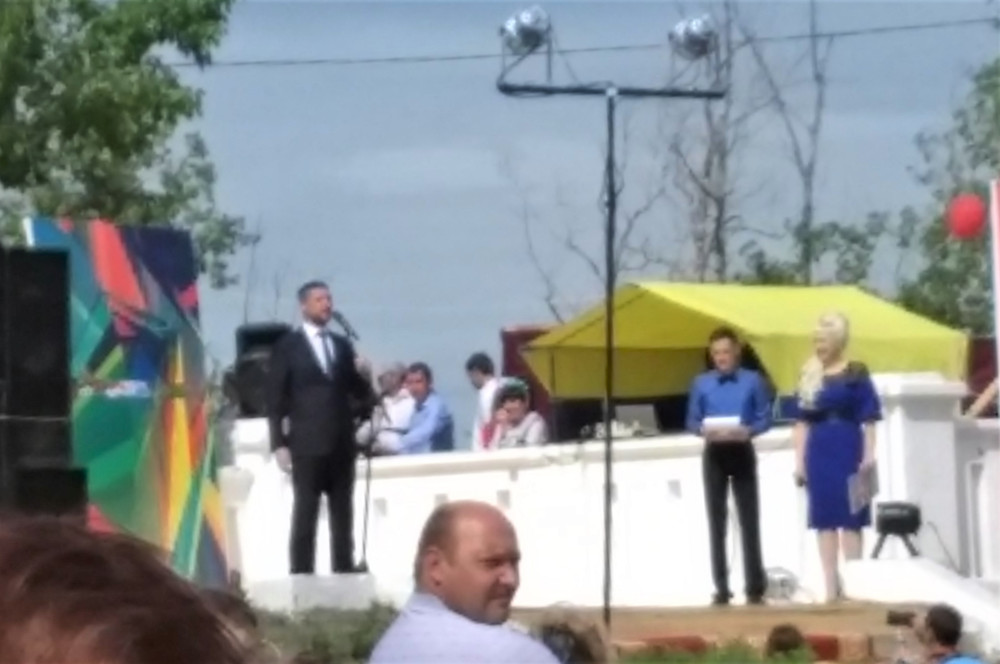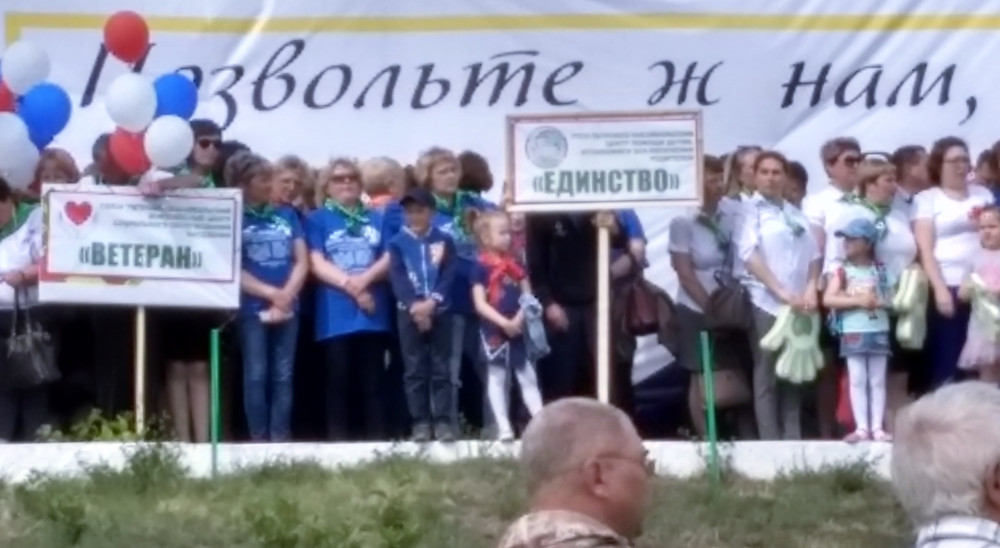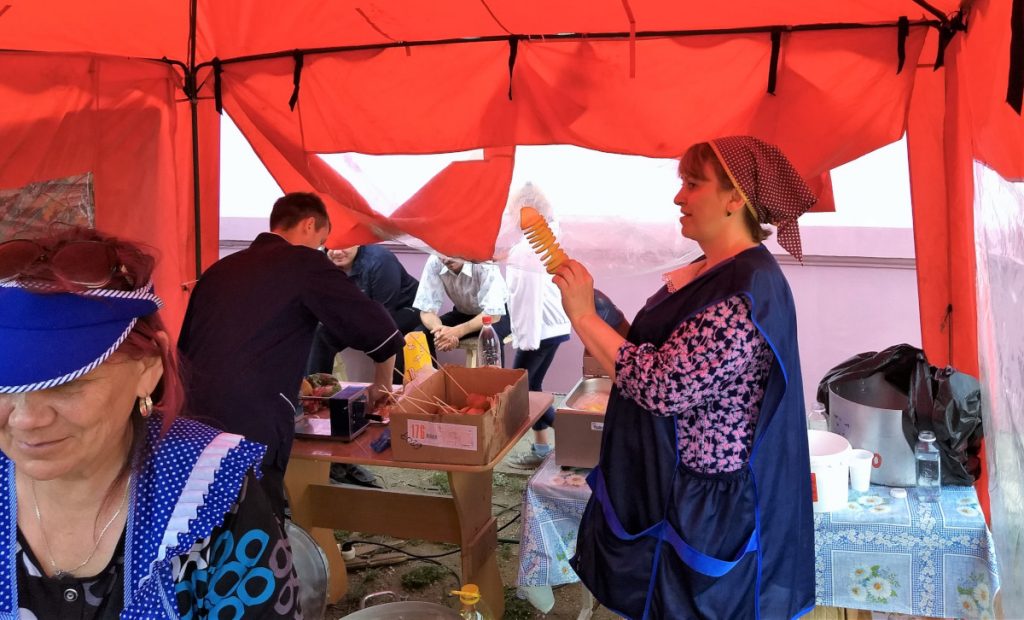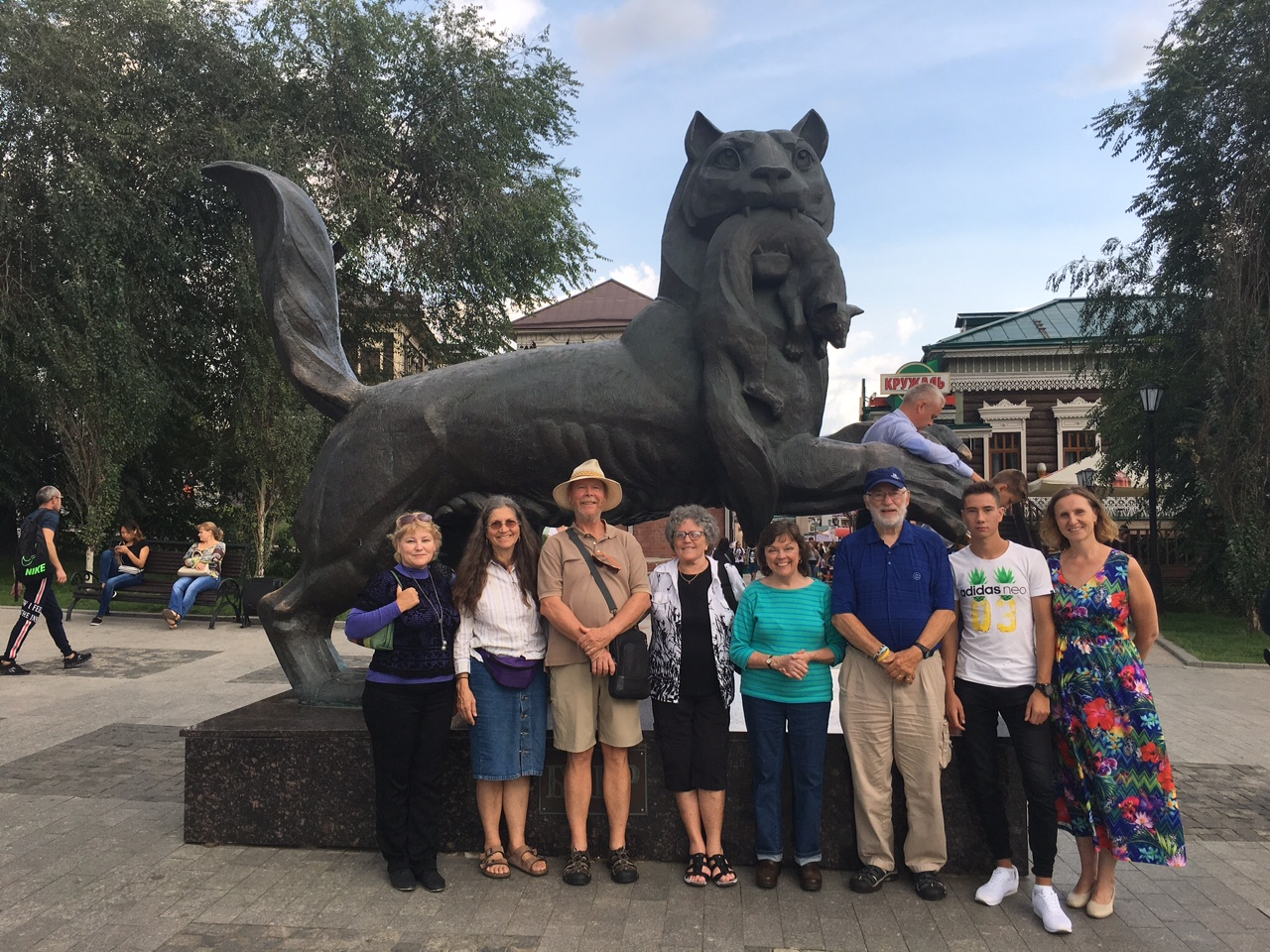Tom in Chita 2019, No. 4: PETROVSK-ZABAIKALSKY’S DAY OF THE CITY AND DAY OF RUSSIA (JUNE 12)

Besides the Decembrist Festival there was also the Day of the City or birthday celebration of the town that was planned to coincide with the post-Soviet holiday, Day of Russia, which is set for June 12th. These two holidays, plus the festival were enough to get the new interim governor of Zabaikalsky Krai, Mr Osipov, to attend the festivities.

June 12th began for us, Olga, Elena and I, with the opening of the Decembrist Festival art exhibition in a large gallery space of the Palace of Sport and Culture, a grand Stalin-era hall looking down from its perch up a hill about 50 vertical feet from the town square, an oval plaza with the statue of Lenin on its left facing the town’s widest boulevard off to the right.

Immediately following the opening, there was a special re-dedication of the “Druzhba” steps climbing the hill alongside the Palace of Sport and Culture. After they were built, presumably around the time the Palace or its predecessor(s) was built, they became part of the town’s traditions. “Druzhba” means friendship, and a ceremony of climbing these steps was connected to local wedding day customs. The steps fell into disrepair, but, at the urging of our favorite director of the Children’s Center, Natalia Skliarova!, they were restored, with a wire sculpture of bride and groom installed next to them, and two new benches placed along the 100 meter long steps. One of the benches dips so the two sitting in it have no choice but to be close! The crowd climbed the balloon-festooned steps one by one.
Meanwhile, I was collected by Kirill and his younger brother, Zhenya, two boys from the Children’s Center and we walked the few meters down to the square, joining the gathering crowd. Kirill and Zhenya left me to get ready for the concert that would follow the ceremonies.

Down the main boulevard a parade of people was lined up waiting. They were grouped by their work units, ready to circle the plaza and take their places on the long wide areas that flanked the stage facing the plaza. Up the steep staircase behind the stage was the Palace of Sport and Culture.
Soon, Natalia Gorbushina, Director of the Palace of Sport and Culture and a young man shared announcing duties for the ceremonies. After comments by both they welcomed the Governor to the celebration of the Day of the City, honoring its 230th birthday. Then the main part began. One by one each work unit was introduced and they walked in formation onto the road that ringed the plaza, the formations sometimes loose, sometimes more formal. If it was a uniformed unit, like the police, or the interior service (security) they were in their uniforms. If not, some groups wore same colored neckerchiefs, or t-shirts, and sometimes just waved banners or flags that matched. The largest single group seemed to be one of the teacher groups (which was notably to me, one of the most informally dressed).

Our favorites, the “Unity” Children’s Center, appeared early in the parade, after the police and state bank (“Sperbank”) and before the schools. They looked very sharp hoisting blue banners while sporting remarkably attractive royal blue (“Antique Royal Blue” actually. I should know, I made the order.) Siberian Bridges t-shirts, which they have apparently adopted as their “uniform” when a uniform is called for. A tear nearly came to my eye…ok, that’s a bit much…
A friend of mine, a teacher in Chita, said she had participated in the same parade a couple of weeks earlier at Chita’s Day of the City. She didn’t like it, I think because it was supposed to be voluntary, but it was the kind of “voluntary” it didn’t do to miss for the sake of good vibes at the office. While I understand her view, I must say I liked the parading of everyone in town with each other on a day celebrating the town, celebrating not just the town but the people making it function. The parade was long only because everyone was included, but the actual distance was short and it was got through as quickly and efficiently as could be done.
When all the groups were in place lined up along each side of the stage, the Interim Governor, Alexander Osipov, gave a short appropriately positive and uncontroversial speech. He is a young man from the Moscow region, in his 40s I think, trim and erect in his dark suit and tie, dark hair and fashionable two-day growth of beard. He was appointed last fall on the resignation of the previous governor. I asked whether she was liked and was told repeatedly that she was not. I haven’t gotten much into local politics questions, but was told that on his arrival he right away began to change the leadership of departments and ask for results, though offering no new funding. I read at a Chita news site that he claimed there was a lot of funding allotted to the region for infrastructure and departments, but remarkably little to show for it, and he wanted an accounting and action on the slated projects. I was told his approval ratings are very high right now, not because he is effective, six months is a short tenure, but because he says the right things, inspiring some hope, and at the same time, one can say he hasn’t failed yet. He has announced that he will be running in the election for the position based on the polling that shows the population seems to have confidence in him.
After his speech, there was my favorite part of the ceremonies, a circle dance to which everyone was invited. Traditional Russian dance music was cranked out of the loudspeakers, and group by group stepped down from the stage area holding hands and dancing their way around the oval plaza, joined by anyone from the street. Governor Osipov joined the dance, holding hands with a woman in Buryat ceremonial clothing. It was really quite moving to see the tops of heads gently bobbing to the music as they circled around us, we who were the crowd on the plaza, round and round. The only problem with the dance was that the music stopped too soon. People were rather shy at first and only toward what turned out to the be end of it, did they start to join, seeing how much fun it all was.
Around the plaza people set up tables and sold handicrafts. At one point in the afternoon, Natalia Skliarova brought us to one of the tables where the crafts were made by kids with mental disabilities. She asked me to choose a gift for myself and also for my mother, who had donated a large part of her doll collection last year to the Children’s Center. I learned that those dolls are now prominently displayed in the Center’s newly enlarged museum. She also said I should pick something for the much-loved and chronically missed, “Mister Chuck”. (I got Mom a little red bear, and Chuck and I got a couple of little sheep, all three of stuffed felted wool and beautifully made.)


Along the boulevard everyone and his brother (it seemed) set up a shashlik grill, home-welded steel affairs on legs consisting of a woodbox with a chimney on one end that opens to a 3-4 foot 8 inch deep tray, just the right width for the shashlik skewers. A pile of firewood lies next to the grills and the woodboxes are fed all day long. When the coals are ready, they’re spread into the trays, a few sprinkles of water periodically keeping them from flaring up. Over this are lined up the skewers of pork or lamb chunks, that have been soaking in the secret (or not so secret) marinades all morning. Each grillmaster had set up a couple of tables with chairs alongside and the one we ate at (finally!), one womaned by a Children’s Center staff member, served the shashlik with a piece of brown bread, ketchup*, and a plastic cup of milk tea, though you could buy beer and bring that if you wanted to.
*SIDE-NOTE: Ketchup is ubiquitous here. The small supermarket near my apartment in Chita has at least 10 types to buy featuring different flavors–with garlic, with sweet red peppers, “shashlik” style, “Bavarian” style, and so on, including several organic types. Michael Shipley, long-time American resident here in Chita, said that the arrival of Heinz ketchup really made a dent in the sales of the others. He couldn’t explain why, though.

There was one vendor who had a hand-cranked spiral cutting device and was spiral cutting half potatoes, skewering them on sticks, fanning the spirals and then deep frying for a few minutes: a spiral potato chip cooked up fresh! It fact, it was our old friend from the Center, Lyosha, former resident, and now cook there, who was manning the spiral cutter.
The aroma of the wood fires and shashlik smoke wafting over the plaza the whole duration of the ceremonies drove me nuts, and I was finally glad to get to taste it all. (My inner vegetarian wannabe-knowseverythingwouldbebetterifIwas seemed to have suddenly departed for Thailand or something).
Then there was the concert. A couple groups in traditional costume sang. And then the Children’s Center was given a full half-hour to present its talented musicians with a special focus on Vitaly Tolochkin, now 12, and Zoya Chizhkova, now 14, the two who placed prominently in the 2017 “You’re Super!” televised children’s singing competition. (NOTE: this format is very popular in Russia and I’m aware of two more such competitions, one of them also focusing on youth.) Vitaly made it to the finals in this year’s competition in the spring. Both sang solos and a couple of duets. Zoya had a song with a traditional women’s group in full costume, and Vitaly sang a rousing patriotic song with an adult male singer who was clearly well-known, to end their set. Perhaps the most moving to me was an early number with Vitaly. He sang with a band of four boys from the Center on drums, guitar, bass guitar and keyboards, Kirill and his little brother Zhenya were bass guitar and guitar, and my friend Vanya was on drums. They’d been working on this during the year, and it was an honorable effort full of potential—good rhythm, good technique and good support for Vitaly. Siberian Bridges has hoped to support instrumental music at the Center, and it is inspiring to know they have already begun so well. (Sorry, I didn’t get a video…)
They were followed by more groups, a couple of which included dancers with singers, one had ballroom dancing, another ballet. But the day was growing long and we, Olga, Elena and I, moseyed back in the dimming light to our apartment, the new practice apartment, at the Children’s Center. We heard the closing fireworks show over tea in the apartment’s kitchen.
THE PRACTICE APARTMENT
Which brings me to this apartment—unrelated to the day’s festivities, but it needs a big mention. This apartment is a new feature of the Children’s Center as of this year. Every child is ejected from the Center at age 18 by law. Suddenly they are in the world and on their own. The apartment, another brainchild of the director, is a chance to practice at independence before it is thrust upon them. They are responsible for cooking, cleaning, buying food, keeping a schedule and working within a budget, all under the guidance of the Center’s staff. The apartment has a small living room with TV, couch and desk, a bedroom with two beds, a fully working small kitchen, fridge with freezer, WC and bathroom with washing machine.
Natalia Skliarova told us that the kids are given training in the various skills needed and also paired up with a roommate. The term of the test is typically two weeks. Some can make it, some haven’t made it past the first few days. The roommate pairing has an importance for the future, because if the pairing is successful, the two can move into an apartment on leaving and support each other. Following a presentation made last fall in Vladivostok at a large conference of Children’s Centers leadership across the Russian Far East and eastern Siberia, she said that some of the other Children’s Centers are very interested in taking on this project at their own Centers. Very exciting!

The next day, we departed early from the Decembrist presentation at the Music School to get to the train station for the seven-hour overnight trip back to Chita. We were joined by the Center’s young celebrity singer, Vitaly Tolochkin, traveling to Chita to visit his beloved stepfather (who had to give him up due to poverty). Another 12-year-old was in a seat nearby and his curiosity brought him to our foursome. We played a couple hands of “Durak” (“Fool”) a mainstay of the Russian card playing—and very confusing to me. Vitaly and Sergey, the boy on the train, from Irkutsk it happens, played video games on the phone, and when Sergey saw the difficulty Vitaly was having with the little English lessons Olga was throwing at him, he mentioned that he was very good at English, probably better than the rest of them…at which point I whispered to him that both Elena and Olga were professors of English! It was for me another lovely Siberian train experience. I’m happy to mention that the train car was quite new, clean and comfortable, and equipped with USB ports and outlets. The bathrooms—two per car—were really nice, something that was not always the case a couple decades before. After some hours of sleep, we arrived at 6:30am to a bright, warm Chita. A quick taxi ride back to KSK, an hour of sleep, and I was back at work in the English day camp at 9.



